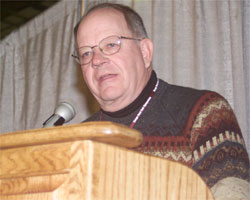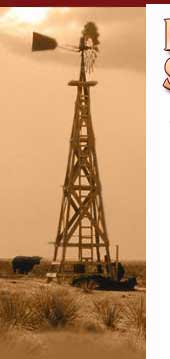|
Use of irrigated pastures and economics of establishment and grazing
Dick Clark, Head of Ag Economics, UNL and Jerry Volesky, Range and Forage Specialist, UNL

Dick Clark, ag economist, talked about the economical considerations for irrigated pasture — cost for pasture establishment, annual operating costs and opportunity costs.

Jerry Volesky, range and forage specialist, talked about on how irrigated pasture can result in higher animal production per acre.
|
|
It’s obvious that irrigated pastures can help boost the amount of beef produced per acre. But at what cost? That was the topic tackled by University of Nebraska (NU) ag specialists Jerry Volesky and Dick Clark at the 2003 Range Beef Cow Symposium.
Clark, an ag economist, said producers need to consider three factors in weighing the economics of making irrigated pastures pay, including:
1) cost for pasture establishment,
2) annual operating costs for grazing and maintaining the pasture, and
3) the opportunity cost of alternative uses on that land, including the effect on farm-program payments.
While first-year establishment costs can run about $175 per acre, Clark said that, when looking at the big picture, that is possibly worthwhile. "When properly managed, some of these pastures can last 25 years. So if you spread that cost out, you may only be looking at a cost of about $12 per acre over that time period."
He added that often the extra pounds of beef produced can also be profitable, despite the expense.
But economics is not the only factor to consider when deciding if irrigated pastures fit your operation. Volesky, a range and forage specialist, said management and how you intend to utilize your irrigated pastures also need to be evaluated. "You must have an understanding of irrigation, fertilization and grazing management as well as the types of forages you intend to plant, grow and graze," he said. Volesky offered these factors to consider:
1. Consider the type of forages you plant. Volesky reported that cool-season perennials are typically the most popular in irrigated grazing programs. He said it is most common to find irrigated pastures that are a mix of orchard grass, smooth brome, meadow brome, creeping foxtail and alfalfa. But, he added, "Annuals can be successful, too, especially if used in a double-cropping system." As an example, he said, a cool-season annual would be planted first, such as wheat rye or oats, followed by a warm-season annual such as forage sorghum or sudangrass.
2. Do a good job in establishing the pasture. "Pay attention to planting dates, seedbed preparation, planting depth, etc. It’s important to get the job done right the first time," he said.
3. Manage your irrigation. "Irrigation done at higher frequency and lesser amount is typically best, because cool-season grasses have a shallow root system," Volesky said. He suggested irrigating every six to seven days and three-quarters of an inch at a time. Obviously in a dry year, watering needs will increase.
4. Manage your grazing. "Some type of rotational grazing with these systems is important. We’ve found five to six paddocks with a rest of 25 to 30 days works well," Volesky said. But he added that flexibility and paying attention to stubble height is important in deciding when to move animals. "Too many pastures are grazed too short, like within 2 to 3 inches of the ground," he said. A stubble height of 6 to 9 inches is a better level to leave.
Lastly, Volesky said there are a lot of possibilities in utilizing irrigated pastures suited to cow-calf pairs and/or stockers. "You just need to use your imagination," he said. Possible examples include:
•grazing pairs from April through July and then moving them to native pastures, stockpiling the irrigated forage and returning to those pastures in the fall
•grazing stockers ahead of pairs in the irrigated system
•running pairs on the irrigated pastures from May to August, weaning the calves and putting them back on the irrigated pastures and moving the cows to native range.
— by Kindra Gordon
Click here to download the presentation (in pdf format).
You will need Acrobat Reader to view.
Click the image to download a free copy.
Click here to listen to the presentations:
Volesky
Clark
You will need Windows Media Player to listen in.
Click here to download a free version.
|
